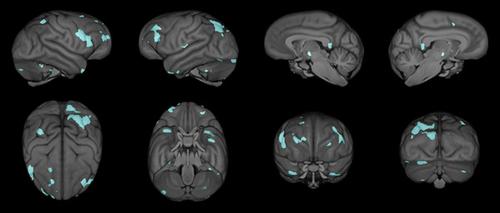当前位置:
X-MOL 学术
›
Am. J. Primatol.
›
论文详情
Our official English website, www.x-mol.net, welcomes your
feedback! (Note: you will need to create a separate account there.)
Age- and cognition-related differences in the gray matter volume of the chimpanzee brain (Pan troglodytes): A voxel-based morphometry and conjunction analysis
American Journal of Primatology ( IF 2.0 ) Pub Date : 2021-04-26 , DOI: 10.1002/ajp.23264 Michele M Mulholland 1 , Chet C Sherwood 2 , Steven J Schapiro 1, 3 , Mary Ann Raghanti 4 , William D Hopkins 1
American Journal of Primatology ( IF 2.0 ) Pub Date : 2021-04-26 , DOI: 10.1002/ajp.23264 Michele M Mulholland 1 , Chet C Sherwood 2 , Steven J Schapiro 1, 3 , Mary Ann Raghanti 4 , William D Hopkins 1
Affiliation

|
Several primate species have been shown to exhibit age-related changes in cognition, brain, and behavior. However, severe neurodegenerative illnesses, such as Alzheimer's disease (AD), were once thought to be uniquely human. Recently, some chimpanzees naturally were documented to develop both neurofibrillary tangles and amyloid plaques, the main characteristics of AD pathology. In addition, like humans and other primates, chimpanzees show similar declines in cognition and motor function with age. Here, we used voxel-based morphometry to examine the relationships among gray matter volume, age, and cognition using magnetic resonance imaging scans previously acquired from chimpanzees (N = 216). We first determined the relationship between age and gray matter volume, identifying the regions that declined with age. With a subset of our sample (N = 103), we also determined differences in gray matter volume between older chimpanzees with higher cognition scores than expected for their age, and older chimpanzees with lower than expected scores. Finally, we ran a conjunction analysis to determine any overlap in brain regions between these two analyses. We found that as chimpanzees age, they lose gray matter in regions associated with cognition. In addition, cognitively healthy older chimpanzees (those performing better for their age) have greater gray matter volume in many brain regions compared with chimpanzees who underperform for their age. Finally, the conjunction analysis revealed that regions of age-related decline overlap with the regions that differ between cognitively healthy chimpanzees and those who underperform. This study provides further evidence that chimpanzees are an important model for research on the neurobiology of aging. Future studies should investigate the effects of cognitive stimulation on both cognitive performance and brain structure in aging nonhuman primates.
中文翻译:

黑猩猩大脑(Pan troglodytes)灰质体积的年龄和认知相关差异:基于体素的形态测量和连接分析
一些灵长类动物已被证明在认知、大脑和行为方面表现出与年龄相关的变化。然而,严重的神经退行性疾病,如阿尔茨海默病 (AD),曾被认为是人类独有的。最近,一些黑猩猩自然地被证明会发展出神经原纤维缠结和淀粉样斑块,这是 AD 病理学的主要特征。此外,与人类和其他灵长类动物一样,黑猩猩的认知和运动功能也随着年龄的增长而下降。在这里,我们使用基于体素的形态测量来检查灰质体积、年龄和认知之间的关系,使用之前从黑猩猩获得的磁共振成像扫描(N = 216)。我们首先确定了年龄和灰质体积之间的关系,确定了随着年龄的增长而下降的区域。使用我们样本的一个子集(N = 103),我们还确定了认知分数高于其年龄预期的老年黑猩猩与低于预期分数的老年黑猩猩之间灰质体积的差异。最后,我们进行了联合分析,以确定这两个分析之间大脑区域的任何重叠。我们发现,随着黑猩猩年龄的增长,它们会在与认知相关的区域失去灰质。此外,与同龄表现不佳的黑猩猩相比,认知健康的老年黑猩猩(与同龄人相比表现更好)在许多大脑区域的灰质体积更大。最后,联合分析显示,与年龄相关的衰退区域与认知健康的黑猩猩和表现不佳的黑猩猩之间的差异区域重叠。这项研究进一步证明黑猩猩是研究衰老神经生物学的重要模型。未来的研究应该调查认知刺激对衰老的非人类灵长类动物的认知表现和大脑结构的影响。
更新日期:2021-04-26
中文翻译:

黑猩猩大脑(Pan troglodytes)灰质体积的年龄和认知相关差异:基于体素的形态测量和连接分析
一些灵长类动物已被证明在认知、大脑和行为方面表现出与年龄相关的变化。然而,严重的神经退行性疾病,如阿尔茨海默病 (AD),曾被认为是人类独有的。最近,一些黑猩猩自然地被证明会发展出神经原纤维缠结和淀粉样斑块,这是 AD 病理学的主要特征。此外,与人类和其他灵长类动物一样,黑猩猩的认知和运动功能也随着年龄的增长而下降。在这里,我们使用基于体素的形态测量来检查灰质体积、年龄和认知之间的关系,使用之前从黑猩猩获得的磁共振成像扫描(N = 216)。我们首先确定了年龄和灰质体积之间的关系,确定了随着年龄的增长而下降的区域。使用我们样本的一个子集(N = 103),我们还确定了认知分数高于其年龄预期的老年黑猩猩与低于预期分数的老年黑猩猩之间灰质体积的差异。最后,我们进行了联合分析,以确定这两个分析之间大脑区域的任何重叠。我们发现,随着黑猩猩年龄的增长,它们会在与认知相关的区域失去灰质。此外,与同龄表现不佳的黑猩猩相比,认知健康的老年黑猩猩(与同龄人相比表现更好)在许多大脑区域的灰质体积更大。最后,联合分析显示,与年龄相关的衰退区域与认知健康的黑猩猩和表现不佳的黑猩猩之间的差异区域重叠。这项研究进一步证明黑猩猩是研究衰老神经生物学的重要模型。未来的研究应该调查认知刺激对衰老的非人类灵长类动物的认知表现和大脑结构的影响。











































 京公网安备 11010802027423号
京公网安备 11010802027423号